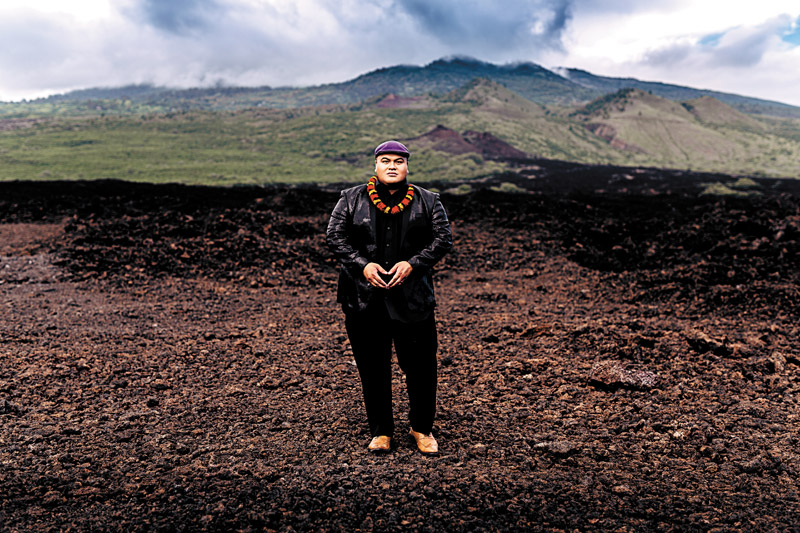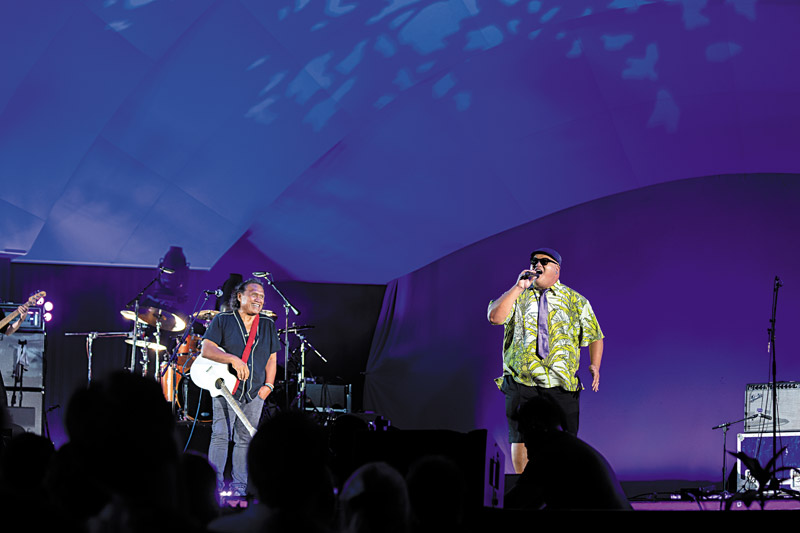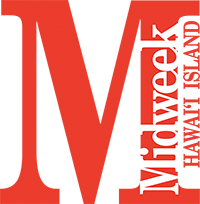Music Saved My Life

Story By Jaimie Kim Farinas
Discovering a gift for song helped Kalani Pe‘a overcome a speech impediment at a young age. Now, the Grammy Award-winner is using his talent to push the envelope and wow the world with his musical fluency.
The first thing that anyone should know about Grammy Award-winning singer Kalani Pe‘a is that he loves the color purple. Like, really loves it. So much so that if Pe‘a had any say, school buses would be painted that hue. Grass definitely would not be green.
He’s known as “The Purple King.”
“In my break room, when people drop off roses, purple roses, or ribbons and gifts — it’s all wrapped in purple,” says an enthused Pe‘a. “It makes me so happy. I am so focused after that. Once I see something that’s purple, I tend to just want to slay once I get on stage because purple’s the best color in the world.”
The second thing to know about Pe‘a is that, despite the recognition and awards the 35-year-old has amassed in only a couple of years, he hasn’t changed in the slightest. He hopes to get back to playing tennis, for example, and drawing (among his many talents, Pe‘a has illustrated and published Hawaiian language children’s stories). He enjoys shopping, and buying gifts for others, like chocolates and food to “get them fat and make them happy.” He likes to fry butter rolls for his mom, and longtime fiancé and manager Allan B. Cool, the latter of whom he describes as “everything to me — my best friend; the person I vent to; the person I tell, at the end of the day, ‘I love you no matter what.'”
In other words, he’s just a regular guy.

Kalani Pe‘a performs alongside Henry Kapono at Waikiki Shell.PHOTO COURTESY DEIRDRE MADRID
“I’m a normal Hawaiian homestead boy that never changed,” says Pe‘a. “Accolades never changed me. People change on their own, and I believe that I’ve been the same guy my whole life.”
And Pe‘a wants the world to know that he’s only just getting warmed up.
“I tell everyone, ‘akahi a ho‘omaka,'” he says. “My journey has just begun.”
At around the age of 2 or 3, when toddlers generally begin babbling less and talking more, it became apparent that a young Pe‘a had a speech impediment. Prone to stuttering and stammering, Pe‘a’s worried mother sent him to a speech therapist, which did little to help (though it would later greatly influence his educational pursuits).
And then, on one fateful day in J.C. Penney at Kaiko‘o Mall in his native Hilo, an almost-4-year-old Pe‘a became separated from his parents. When they found him, Pe‘a was singing to a mannequin.
“My mom realized I love music,” says Pe‘a, who grew up in Pana‘ewa.
It’s no wonder, either. He remembers his father, an electric jazz bass player, experimenting in the garage with Hawaiian and contemporary soul music. His mother sang to the Carpenters, and other tunes from the ’70s and ’80s.
Recognizing where Pe‘a’s interests lay, his parents got him involved in vocal lessons and choirs, like Nā Pua No‘eau (Center for Gifted & Talented Native Hawaiian Children) Kamalani Children’s Chorus. He began taking talent competitions by storm, and performing at pageants as “that young boy with the overly dressed, oversized men’s shop suit.” He opened for the likes of Kapena and Ilona Irvine.
Just like that, somewhere along the way, his difficulties with speaking dissipated.
“Music stopped my speech impediment throughout my entire life,” says Pe‘a. “Music saved my life. Writing music, arranging music saved my life. It allowed me to be who I am today: a confident gay man; a Hawaiian man; a man of integrity and cultural values and practices.”
But his path to a professional career in music was not so clear-cut.
Thanks to scholarships, Pe‘a attended Colorado Mesa University (at the time, Mesa State College) after graduating from Ke Kula ‘O Nāwahīokalani‘ōpu‘u, a Hawaiian language medium laboratory school in Kea‘au, Puna. In his freshman year there, Pe‘a decided to major in music performance. But giving in to a more practical side and concerns it would lead nowhere, Pe‘a switched concentrations and settled on mass communications instead, going on to work in media for a period of time.
Then, wanting to help others, and inspired by his own speech impediment growing up, Pe‘a began working on a master’s degree in early education and teaching at Kamehameha Schools – Maui.
In the midst of all this, Pe‘a never abandoned his passion for music.
“Music is in my soul, in my thinking, in the way I conduct myself,” says Pe‘a. “I’ve always known that music’s always going to be a part of my life.”
It wasn’t until the age of 32, when Pe‘a found himself singing in a bar for free, that things really began to change.
“My other half, Allan, stated, ‘This is nonsense … you’re wasting your life away not putting your original music on an album; do it,'” recalls Pe‘a.
“Because of him and his values, and because of my parents and their values, I was able to feel confident to start my first album.”
Pe‘a debuted E Walea (which means “to be exuberant, relax and enjoy”) back in 2016, and its popularity soon proved itself on iTunes and Billboard charts, as well as with the Recording Academy. On Feb. 12, 2017, Pe‘a made history by winning a Grammy Award for Best Regional Roots Music Album, becoming the first Hawaiian recording artist ever to win in that category (an accomplishment Pe‘a credits with allowing him to focus on music full time). Then, a couple of months later, Pe‘a took home a Nā Hōkū Hanohano Award for Contemporary Album of the Year.
So it should come as no surprise that Pe‘a’s sophomore album — No ‘Ane‘i (We Belong Here), which came out in August — is being met with similar acclaim. In fact, when the Recording Academy announced the nominees for its 61st annual Grammy Awards earlier this month, Pe‘a found out that he’s up again for Best Regional Roots Music Album. (Winners will be announced Feb. 10, 2019.)
“All I did was cry,” says Pe‘a. “It’s a blessing. It’s all about hard work, and devoting our time and energy into our craft. When we work hard, promote and share our music from a local and global platform, we are sharing aloha. What a huge honor.”
The 12-track album features everything from original music to an oli (chant), a song with Amy Hānaiali‘i Gilliom and Willie K (Hilo March), and cover of the Carpenters’ Superstar. Inspired by just about everything, Pe‘a writes his music in just 5-10 minutes.
In reflecting on how he put No ‘Ane‘i together, Pe‘a thinks back to his Grammy Award acceptance speech.
“I said, ‘kau ka pe‘a, holo ka wa‘a,’ metaphorically meaning, put up the sail and let us row, row, row our boats; let us bring our paddles and maybe become that team as we move forward and paddle ahead,” says Pe‘a, later adding that it translates as “the sail is up, the boat must go.”
“I thought of my foundation, my roots in Hawaiian language,” he adds. “I thought about all of us in Hawai‘i becoming a prominent, profound resource.”
He goes on to explain that it doesn’t matter what a person wants to do with their life — be it becoming a doctor, lawyer, farmer or lei-maker. Become who you are meant to be, and in doing so, contribute to the fabric of Hawai‘i.
“I am a singer, songwriter, educator — I tell everybody that,” says Pe‘a. “Own your talent. Own your gift. That is the theme of the album. Become that resource.”
For a recording artist, especially one whose first language is Hawaiian, No ‘Ane‘i, and even E Walea, can be described as rather eclectic. As much as both show off a prowess for Hawaiian music, they also are examples of Pe‘a’s mastery of other genres, such as contemporary and R&B tunes.
To outsiders looking in, it might appear that Pe‘a is pandering to a broad demographic; to stand out by being different. But that couldn’t be further from the truth.
“This is who I am,” he says. “I’ve been this since I first serenaded that one mannequin in J.C. Penney — that boy that’s all about innovation and creativity and thinking beyond the box and pushing the envelope.”
And his contemporaries have always accepted him with warmth — something Pe‘a points to as having encouraged him throughout his journey.
They have nice things to say about him, too.
“Kalani was a joy to work with … I’m excited to see what the future holds for him,” says Gilliom.
“Kalani brings a lot of energy with his performance, and you can really feel the passion,” says Chris Kamaka, who, along with Ho‘okena and the Mākaha Sons’ Louis “Moon” Kauakahi, appears on No ‘Ane‘i in ‘Elala He Inoa. “It’s so nice to see and hear what he has to offer. We, Ho‘okena, are very proud of what he has accomplished, and how he inspires other musicians young and old, as well as Hawaiians and Hawaiians-at-heart around the world.”
“He has a very powerful voice and is very committed to his culture, and presents his views in a very charming and enlightening way,” says Henry Kapono. “He’ll go far, and he wears his aloha proudly.”
So perhaps most profound is how Pe‘a continues to break new ground without sacrificing who he is — and don’t expect that to change any time soon.
“Pushing the envelope is showing that we put something different in that envelope — whether it’s a purple car or pink leather — and we seal it with our love. We sign, seal, deliver that envelope, and then we share it to the world, metaphorically saying, ‘This is who I am.’
“This is who I am, and I’m going to be who I am.”
Pe‘a will embark on his Music for the Soul tour in January, traveling around the mainland. Tickets also are already on sale for his debut showcase at Hawai‘i Theatre on O‘ahu May 3, 2019.
For more information on Pe‘a, visit kalanipeamusic.com, and find him on Facebook and Instagram (@kalanipeamusic).

